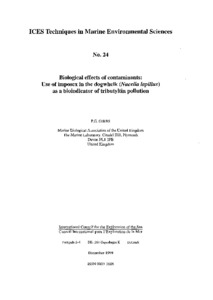| dc.contributor.author | Gibbs, P. E. | |
| dc.date.accessioned | 2019-01-16T00:40:37Z | |
| dc.date.available | 2019-01-16T00:40:37Z | |
| dc.date.issued | 1999 | |
| dc.identifier.citation | Gibbs, P. E. (1999) Biological effects of contaminants: Use of imposex in the dogwhelk (Nucella lapillus) as a bioindicator of tributyltin pollution. ICES Techniques in Marine Environmental Sciences, No. 24, 29pp. DOI: http://dx.doi.org/10.25607/OBP-272 | en_US |
| dc.identifier.issn | 0903–2606 | |
| dc.identifier.uri | http://hdl.handle.net/11329/715 | |
| dc.identifier.uri | http://dx.doi.org/10.25607/OBP-272 | |
| dc.description.abstract | This document describes a method for detecting contamination of the marine environment by tributyltin (TBT) using a sensitive neogastropod, the dogwhelk Nucella lapillus (L.), as a bioindicator. Exposure of female N. lapillus to TBT induces masculinization; this induction of masculinization has been termed 'imposex'. The indices that have been employed to measure imposex in N. lapillus are described here, together with a brief account of the biology of this organism. | en_US |
| dc.language.iso | en | en_US |
| dc.publisher | International Council for the Exploration of the Sea (ICES) | en_US |
| dc.relation.ispartofseries | ICES Techniques in Marine Environmental Sciences; 24 | |
| dc.title | Biological effects of contaminants: Use of imposex in the dogwhelk (Nucella lapillus) as a bioindicator of tributyltin pollution. | en_US |
| dc.type | Report | en_US |
| dc.description.status | Published | en_US |
| dc.format.pages | 29pp. | en_US |
| dc.description.refereed | Refereed | en_US |
| dc.publisher.place | Copenhagen, Denmark | en_US |
| dc.description.currentstatus | Current | en_US |
| dc.description.sdg | 14.1 | |
| dc.description.bptype | Standard Operating Procedure | en_US |
| dc.description.bptype | Guide | en_US |
| obps.contact.contactemail | info@ices.dk | |
| obps.resourceurl.publisher | http://ices.dk/publications/library/ | en_US |
 Repository of community practices in Ocean Research, Applications and Data/Information Management
Repository of community practices in Ocean Research, Applications and Data/Information Management
